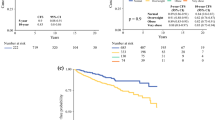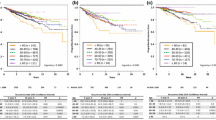Abstract
Obesity is associated with adverse biologic features and poor outcome in patients with invasive breast cancer, yet this relationship has not been evaluated in patients with ductal carcinoma in situ (DCIS). From 1996 to 2009, body mass index (BMI) was recorded at initial diagnosis for 1,885 patients with DCIS treated at our institution. Patients were categorized as obese (BMI ≥ 30 kg/m2), overweight (BMI 25 to <30 kg/m2), or of normal weight or underweight (BMI < 25 kg/m2). Logistic regression was used to examine associations between BMI and patient, clinical, and pathologic features and treatment. Local–regional recurrence was calculated using the Kaplan–Meier method. All statistical tests were two-sided. Of the 1,885 patients, 514 (27.7%) were obese, 510 (27.5%) were overweight, and 831 (44.8%) were normal/underweight. In multivariate analysis, overweight and obese patients were significantly more likely to be African American (odds ratio [OR], 3.93; 95% confidence interval [CI], 2.66–5.80) or Hispanic (OR, 1.44; CI, 1.02–2.04), be postmenopausal (OR, 1.63; CI, 1.28–2.07), have diabetes (OR, 4.60; CI, 2.60–8.12), have estrogen-receptor-positive DCIS (OR, 1.39; CI, 1.00–192), and present with a radiologic abnormality rather than clinical symptoms (OR, 1.35; CI, 1.01–1.80). At a median follow-up time of 4.96 years (range, 1.0–14.34 years), no significant differences in local recurrence rates were detected based on patients’ initial BMI category. Furthermore, there was no significant difference in risk of recurrence between diabetic patients receiving metformin or not. In conclusion, higher BMI is not associated with adverse biologic features or prognosis in patients with DCIS.
Similar content being viewed by others

References
Flegal KM, Carroll MD, Ogden CL, Curtin LR (2010) Prevalence and trends in obesity among US adults, 1999–2008. JAMA 303:235–241. doi:10.1001/jama.2009.2014
Basen-Engquist K, Chang M (2011) Obesity and cancer risk: recent review and evidence. Curr Oncol Rep 13:71–76. doi:10.1007/s11912-010-0139-7
Calle EE, Rodriguez C, Walker-Thurmond K, Thun MJ (2003) Overweight, obesity, and mortality from cancer in a prospectively studied cohort of U.S. adults. N Engl J Med 348:1625–1638. doi:10.1056/NEJMoa021423
Chen X, Lu W, Zheng W, Gu K, Chen Z, Zheng Y, Shu XO (2010) Obesity and weight change in relation to breast cancer survival. Breast Cancer Res Treat 122:823–833. doi:10.1007/s10549-009-0708-3
Dawood S, Broglio K, Gonzalez-Angulo AM, Kau SW, Islam R, Hortobagyi GN, Cristofanilli M (2008) Prognostic value of body mass index in locally advanced breast cancer. Clin Cancer Res 14:1718–1725. doi:10.1158/1078-0432.CCR-07-1479
de Azambuja E, McCaskill-Stevens W, Francis P, Quinaux E, Crown JP, Vicente M, Giuliani R, Nordenskjold B, Gutierez J, Andersson M, Vila MM, Jakesz R, Demol J, Dewar J, Santoro A, Lluch A, Olsen S, Gelber RD, Di Leo A, Piccart-Gebhart M (2010) The effect of body mass index on overall and disease-free survival in node-positive breast cancer patients treated with docetaxel and doxorubicin-containing adjuvant chemotherapy: the experience of the BIG 02–98 trial. Breast Cancer Res Treat 119:145–153. doi:10.1007/s10549-009-0512-0
Ewertz M, Jensen MB, Gunnarsdottir KA, Hojris I, Jakobsen EH, Nielsen D, Stenbygaard LE, Tange UB, Cold S (2011) Effect of obesity on prognosis after early-stage breast cancer. J Clin Oncol 29:25–31. doi:10.1200/JCO.2010.29.7614
Loi S, Milne RL, Friedlander ML, McCredie MR, Giles GG, Hopper JL, Phillips KA (2005) Obesity and outcomes in premenopausal and postmenopausal breast cancer. Cancer Epidemiol Biomarkers Prev 14:1686–1691. doi:10.1158/1055-9965.EPI-05-0042
Cazzaniga M, Bonanni B, Guerrieri-Gonzaga A, Decensi A (2009) Is it time to test metformin in breast cancer clinical trials? Cancer Epidemiol Biomarkers Prev 18:701–705. doi:10.1158/1055-9965.EPI-08-0871
Goodwin PJ, Stambolic V, Lemieux J, Chen BE, Parulekar WR, Gelmon KA, Hershman DL, Hobday TJ, Ligibel JA, Mayer IA, Pritchard KI, Whelan TJ, Rastogi P, Shepherd LE (2011) Evaluation of metformin in early breast cancer: a modification of the traditional paradigm for clinical testing of anti-cancer agents. Breast Cancer Res Treat 126:215–220. doi:10.1007/s10549-010-1224-1
Hadad S, Iwamoto T, Jordan L, Purdie C, Bray S, Baker L, Jellema G, Deharo S, Hardie DG, Pusztai L, Moulder-Thompson S, Dewar JA, Thompson AM (2011) Evidence for biological effects of metformin in operable breast cancer: a pre-operative, window-of-opportunity, randomized trial. Breast Cancer Res Treat 128:783–794. doi:10.1007/s10549-011-1612-1
Daniels SR (2009) The use of BMI in the clinical setting. Pediatrics 124(Suppl 1):S35–S41. doi:10.1542/peds.2008-3586F
Margolis KL, Lihong Q, Brzyski R, Bonds DE, Howard BV, Kempainen S, Simin L, Robinson JG, Safford MM, Tinker LT, Phillips LS (2008) Validity of diabetes self-reports in the Women’s Health Initiative: comparison with medication inventories and fasting glucose measurements. Clin Trials 5:240–247. doi:10.1177/1740774508091749
Dignam JJ, Wieand K, Johnson KA, Fisher B, Xu L, Mamounas EP (2003) Obesity, tamoxifen use, and outcomes in women with estrogen receptor-positive early-stage breast cancer. J Natl Cancer Inst 95:1467–1476
Key TJ, Appleby PN, Reeves GK, Roddam A, Dorgan JF, Longcope C, Stanczyk FZ, Stephenson HE Jr, Falk RT, Miller R, Schatzkin A, Allen DS, Fentiman IS, Wang DY, Dowsett M, Thomas HV, Hankinson SE, Toniolo P, Akhmedkhanov A, Koenig K, Shore RE, Zeleniuch-Jacquotte A, Berrino F, Muti P, Micheli A, Krogh V, Sieri S, Pala V, Venturelli E, Secreto G, Barrett-Connor E, Laughlin GA, Kabuto M, Akiba S, Stevens RG, Neriishi K, Land CE, Cauley JA, Kuller LH, Cummings SR, Helzlsouer KJ, Alberg AJ, Bush TL, Comstock GW, Gordon GB, Miller SR (2003) Body mass index, serum sex hormones, and breast cancer risk in postmenopausal women. J Natl Cancer Inst 95:1218–1226
Rose DP, Vona-Davis L (2009) Influence of obesity on breast cancer receptor status and prognosis. Expert Rev Anticancer Ther 9:1091–1101. doi:10.1586/era.09.71
Kuerer HM (2011) Rational individualised selection of adjuvant therapy for ductal carcinoma in situ. Lancet Oncol 12:2–3. doi:10.1016/S1470-2045(10)70277-1
Sestak I, Distler W, Forbes JF, Dowsett M, Howell A, Cuzick J (2010) Effect of body mass index on recurrences in tamoxifen and anastrozole treated women: an exploratory analysis from the ATAC trial. J Clin Oncol 28:3411–3415. doi:10.1200/JCO.2009.27.2021
El-Tamer MB, Ward BM, Schifftner T, Neumayer L, Khuri S, Henderson W (2007) Morbidity and mortality following breast cancer surgery in women: national benchmarks for standards of care. Ann Surg 245:665–671. doi:10.1097/01.sla.0000245833.48399.9a
Chang DW, Wang B, Robb GL, Reece GP, Miller MJ, Evans GR, Langstein HN, Kroll SS (2000) Effect of obesity on flap and donor-site complications in free transverse rectus abdominis myocutaneous flap breast reconstruction. Plast Reconstr Surg 105:1640–1648
McCarthy CM, Mehrara BJ, Riedel E, Davidge K, Hinson A, Disa JJ, Cordeiro PG, Pusic AL (2008) Predicting complications following expander/implant breast reconstruction: an outcomes analysis based on preoperative clinical risk. Plast Reconstr Surg 121:1886–1892. doi:10.1097/PRS.0b013e31817151c4
Alderman AK, McMahon L, Wilkins EG (2003) The national utilization of immediate and early delayed breast reconstruction and the effect of sociodemographic factors. Plast Reconstr Surg 111:695–703. doi:10.1097/01.Prs.0000041438.50018.02
Sinicrope FA, Dannenberg AJ (2011) Obesity and breast cancer prognosis: weight of the evidence. J Clin Oncol 29:4–7. doi:10.1200/JCO.2010.32.1752
Canchola AJ, Anton-Culver H, Bernstein L, Clarke CA, Henderson K, Ma H, Ursin G, Horn-Ross PL (2012) Body size and the risk of postmenopausal breast cancer subtypes in the California Teachers Study cohort. Cancer Causes Control. doi:10.1007/s10552-012-9897-x
Hartz A, He T, Rimm A (2012) Comparison of adiposity measures as risk factors in postmenopausal women. J Clin Endocrinol Metab 97:227–233. doi:10.1210/jc.2011-1151
McTiernan A, Irwin M, Vongruenigen V (2010) Weight, physical activity, diet, and prognosis in breast and gynecologic cancers. J Clin Oncol 28:4074–4080. doi:10.1200/JCO.2010.27.9752
Harvie M, Howell A, Vierkant RA, Kumar N, Cerhan JR, Kelemen LE, Folsom AR, Sellers TA (2005) Association of gain and loss of weight before and after menopause with risk of postmenopausal breast cancer in the Iowa women’s health study. Cancer Epidemiol Biomarkers Prev 14:656–661. doi:10.1158/1055-9965.EPI-04-0001
Eliassen AH, Colditz GA, Rosner B, Willett WC, Hankinson SE (2006) Adult weight change and risk of postmenopausal breast cancer. JAMA 296:193–201. doi:10.1001/jama.296.2.193
Kerlikowske K, Barclay J, Grady D, Sickles EA, Ernster V (1997) Comparison of risk factors for ductal carcinoma in situ and invasive breast cancer. J Natl Cancer Inst 89:76–82
Reinier KS, Vacek PM, Geller BM (2007) Risk factors for breast carcinoma in situ versus invasive breast cancer in a prospective study of pre- and post-menopausal women. Breast Cancer Res Treat 103:343–348. doi:10.1007/s10549-006-9375-9
Trentham-Dietz A, Newcomb PA, Storer BE, Remington PL (2000) Risk factors for carcinoma in situ of the breast. Cancer Epidemiol Biomarkers Prev 9:697–703
Acknowledgment
Stephanie P. Deming of MD Anderson’s Department of Scientific Publications provided editorial assistance. This research is supported by National Institutes of Health through MD Anderson’s Cancer Center Support Grant, CA016672 and Randalls Food Markets.
Conflict of interest
The authors indicate no potential conflict of interest.
Author information
Authors and Affiliations
Corresponding author
Rights and permissions
About this article
Cite this article
Kuerer, H.M., Lari, S.A., Arun, B.K. et al. Biologic features and prognosis of ductal carcinoma in situ are not adversely impacted by initial large body mass. Breast Cancer Res Treat 133, 1131–1141 (2012). https://doi.org/10.1007/s10549-012-1999-3
Received:
Accepted:
Published:
Issue Date:
DOI: https://doi.org/10.1007/s10549-012-1999-3



